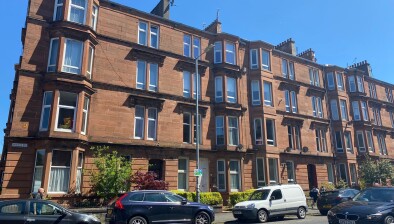Professor Douglas Robertson: Affordability and rent regulation remain highly contested

Professor Douglas Robertson
As the Housing (Scotland) Bill continues its passage through the Scottish Parliament, Professor Douglas Robertson’s overview of the main findings of the RentBetter research project led by Indigo House and funded by the Nationwide Foundation considers affordability and rent controls.
The RentBetter research reveals that far more needs to be done to deliver on affordability in the PRS. The debate surrounding rent control makes much of the data presented in this blog for some contentious. Has the sector been declining, or does the data exaggerate that trend? Landlord registration data suggests a lesser decline, but does that data not have its weaknesses?
Did the temporary ‘emergency’ rent restrictions help or hinder tenants in terms of keeping their rent affordable? Is the rent hike in Scotland really that large when compared to the rest of the UK?
Having access to good data is critical when you are considering both the effectiveness of any policy intervention in the PRS, and the impact that proposed future policies might having on the market functions. But unfortunately, official data covering the PRS is currently quite poor. As the experience of the ill-fated Rent Pressure Zone illustrated if you seek to show localised high rent ‘hot spots’ then you need rent data more akin to that found in Ireland, or across most of Europe.
Information on rents being paid needs to be collected, along with some basic measure of size, quality and all of that needs to be geographically specific. Currently, as none of that exists the prospect of being able to operate some means of rent regulation seems destined to repeat the failure of the Rent Pressure Zones. The basic tools are still not in place.
We know the various pieces of legislation adopted so far, the Rent Pressure Zone, the rent freeze and the rent increase cap, have had very little impact on affordability of the PRS as a whole. Some evidence even suggests rent control in Scotland to date has in fact exacerbated rent rises, but in fact it is likely to be the result of a combination of factors, some of which are common to the rest of the UK – the supply/demand imbalance and a period of high inflation, and increased interest/mortgage rates. Other factors are specific to Scotland.
The regulatory and tax environment (those taxes with differences specific to Scotland), and the rent freeze/cap from late 2022, with landlords and letting agents stating that the combined effect of all these factors are causing them to be more likely to mark-up rents more heavily between tenancies due to their perception of increased risk in the sector.
One of the original policy objectives of the 2016 Act was to “provide more predictable rents and protection for tenants against excessive rent increases”. Rent regulation via Rent Pressure Zones proved to be a complete non-starter. No local authority submitted a case to government as the rent data requirements demanded by the Scottish Government were seen to be just too onerous. Rent adjudication cases, where the tenant considers the rise to be unfair, and requests the Rent Officer intervention, equated to just 0.1% of all Private Residential Tenancies, just 227 cases, so are insignificant.
Finally, both the ‘Covid 19 Pandemic’ and later the ‘Cost of Living Crisis’ brought about emergency rent regulation measures, the first being a rent freeze, the second an in-tenancy rent increase cap of 3%. Both of these short-lived interventions on in-tenancy rent rises did stabilise rents rises for some sitting tenants. However, when that tenancy changed there was evidence of rent increase maximisation on the part of landlords, keen to recoup what they considered previous rent income losses. This is in the context of the RentBetter research showing from Wave 1 back in 2019 and repeated in Wave 3 in 2024, that the norm for rent increases in the PRS is at the change of tenancy – not annually. It is therefore not surprising that the in-tenancy rent cap made little impact in controlling rent levels in the sector as a whole.
This perhaps explains why Scottish rent rises over the last two years, as detailed in official ONS data, have outpaced all other regions in the UK, including London. That said, the Scottish Government’s PRS rental data is derived solely from advertised rents, not the rents actually being paid by sitting tenants, as is the case in England and Wales, so the ONS does acknowledge the Scottish data does create a distortion.
This is important as there is a serious affordability issue across the PRS. The RentBetter study clearly shows that private tenants have learned to accept ever higher rents. They might be paying over 40% of their net income on rent, as almost a quarter of tenants do, so more when they add in Council Tax, electricity and heating, but because that has become the norm within their locality, the experience of friends, neighbours and associates, it’s not seen to be unaffordable. It’s just what the rent is if they want to live in a certain location. Tenants paying such a high proportion of their income on rent are struggling financially, but still consider their rent to be affordable because that is the reality of the current rental market.
But why are rents rising? Well according to the 2022 Scottish Household Survey the PRS stock reduced between March 2017 and March 2022 by around 13%. The Scottish Landlord Register shows a smaller drop of 5% in stock during that same period. As landlord registration lasts for three years there is an obvious time lag built into that data. There is also evidence that rent rises are now more common across the sector, particularly for longer-term renters, since annual increases became a landlords’ legal right embedded within the new PRT and especially when the ‘Cost of Living’ rent cap emergency legislation was enacted.
Looking at both datasets over the long-term the sector grew from 6% of households in the 1990s before peaking between 2016 and 2017 at 15%, with the stock then levelling off at 13%, before declining further in recent years. The most recent period of 2022-24 shows a reduction in landlords on the Scottish Landlord Register by 11%, but an increase in properties. Insights from the qualitative research indicates most of this growth comes from new niche market Purpose Build Student Accommodation.
Over that same period, there has been a 4% growth in Scottish households. Had the PRS expanded so that it still housed 15% of all households, there would need to be some 27,000 more properties within the PRS. So, supply is reducing at a time when demand has increased, thus creating an upward pressure on rents delivering affordability consequences for tenants.
The RentBetter study has consistently shown that an increasing number of landlords talk of exiting the? market. But then this study has also shown landlords have always talked about getting out, but fewer actually do than say they will. However, recent factors such as the recent fiscal changes and the effects of the ‘cost of living crisis’ on mortgage rates, dramatically altered the financial model that many landlords long operated, given that low-interest mortgages just disappeared. Those landlords highly-geared found themselves in serious financial difficulties.
Others without such a debt burden, because they used personal pensions monies to purchase rented property might be tempted to cash in earlier than originally planned. In addition, as the study has also detailed the introduction of emergency rent restrictions during both the Covid 19 Pandemic and ‘Cost of Living crisis’ has impacted on the landlords perception of income and how that might play out in the future.
There has been a significant lowering of confidence from landlords and agents in respect of the future sustainability of the PRS over the last five years. The RentBetter survey showed those who were either very or quite confident in the PRS reduced from 41% in 2019 down to 17% of respondents in 2024. By comparison, those that were not confident increased significantly from 42% in 2019 to 70% by 2024. Now with the Scottish Government actively exploring introducing another rent control measure in its current Housing Bill as a means to ensure rent stability and affordability a potentially additional concern about financial returns plays on landlords’ minds. Could this encourage more to leave the sector?
Any action to limit rents needs very careful consideration. There is much international and historical evidence on rent control which demonstrates its unintended consequences. What is clear from all the evidence collected over the past 5 years through the RentBetter research is that legislation is easy, but ensuring those good intentions follow through into the market is much more difficult.
- Professor Douglas Robertson was the Chair of the Scottish Government Advisory Group between 2009 and 2015 that made recommendations for reform and now sits of the RentBetter Advisory Group.
To access the full set of research reports on the impacts of recent legislative reform on Scotland private rented section visit here.









